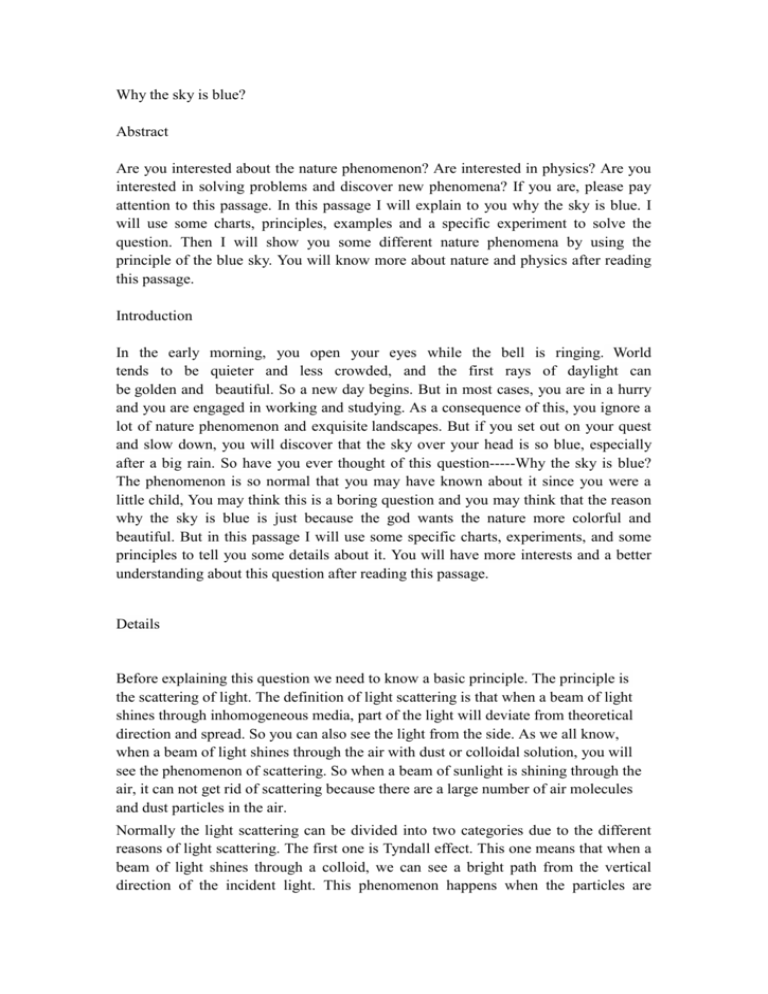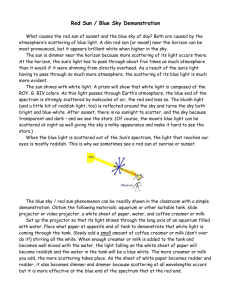Why the sky is blue
advertisement

Why the sky is blue? Abstract Are you interested about the nature phenomenon? Are interested in physics? Are you interested in solving problems and discover new phenomena? If you are, please pay attention to this passage. In this passage I will explain to you why the sky is blue. I will use some charts, principles, examples and a specific experiment to solve the question. Then I will show you some different nature phenomena by using the principle of the blue sky. You will know more about nature and physics after reading this passage. Introduction In the early morning, you open your eyes while the bell is ringing. World tends to be quieter and less crowded, and the first rays of daylight can be golden and beautiful. So a new day begins. But in most cases, you are in a hurry and you are engaged in working and studying. As a consequence of this, you ignore a lot of nature phenomenon and exquisite landscapes. But if you set out on your quest and slow down, you will discover that the sky over your head is so blue, especially after a big rain. So have you ever thought of this question-----Why the sky is blue? The phenomenon is so normal that you may have known about it since you were a little child, You may think this is a boring question and you may think that the reason why the sky is blue is just because the god wants the nature more colorful and beautiful. But in this passage I will use some specific charts, experiments, and some principles to tell you some details about it. You will have more interests and a better understanding about this question after reading this passage. Details Before explaining this question we need to know a basic principle. The principle is the scattering of light. The definition of light scattering is that when a beam of light shines through inhomogeneous media, part of the light will deviate from theoretical direction and spread. So you can also see the light from the side. As we all know, when a beam of light shines through the air with dust or colloidal solution, you will see the phenomenon of scattering. So when a beam of sunlight is shining through the air, it can not get rid of scattering because there are a large number of air molecules and dust particles in the air. Normally the light scattering can be divided into two categories due to the different reasons of light scattering. The first one is Tyndall effect. This one means that when a beam of light shines through a colloid, we can see a bright path from the vertical direction of the incident light. This phenomenon happens when the particles are smaller than the wavelength of the incident light. Besides, the intensity of the light scattering has no business with the wavelength of the light, As a result, you can also see the light is white after scattering. For instance, we can see the phenomenon when we look at the horizon. Besides, this one is also called the scattering of some muddy medium. The second one is Rayleigh scattering. The prerequisite of this phenomenon is that the particles are much smaller than the wavelength of the incident light. It has the following features: ① the scattering intensity is inversely proportional to the biquadrate of the wavelength. ② The forward and backward of the scattering light is the strongest. ③ The Luminous flux of the first half of the particles equal to the rest. ④ The Polarization state of the forward scattered light is the same with the backward scattered light. These features are closely related with the question. And this one means that a beam of light should shine through clean and pure medium. The Rayleigh scattering is the basic principle of explaining why the sky is blue. Here we come back to our question. First of all we must know that the atmosphere around the earth has no color. It is the air particles, ice crystals and water-drops that make the sky colorful. The reason we have discussed above, it is because of the light scattering. But why the sky is blue but not any other colors? As we all know the sunlight is white. But it can be divided into seven colors. They are red, orange, yellow, green, cyan, blue and purple. They have different wavelengths and different frequencies. So their functions are different from each other. For example, when we make an experiment, we can use a prism to resolve different beams of lights. Since their wavelengths are different, some beams of lights may come through but others cannot. To explain this question, let me make an analogy. Let us assume light is wave. When a wave is moving, it will spread around. If the wave meets a tiny stone or something else that can stop it from mowing. The wave will rebound and change its direction. So the sunlight shines through the air, it will meet a lot of obstacles such as air particles, water-drops and some dust. When the sunlight meets these obstacles, they will rebound like a wave and change its direction. But you may still wander that why we still see blue even if many beams of light are stopped by obstacles? As we have discussed, different lights have different wavelengths, some of them have many long wavelengths like red and orange. Their wavelengths can be over 600nm and the red light’s wavelength can be 760nm. But some of them are very short like blue and purple. Their wavelengths are less than 500nm. The purple light’s wavelength can be 350nm(You can see the details from Fig1). Let us use the same analogy, the light which its wavelengths are long is a big wave. They can find ways around obstacles. But the light which wavelengths are short is a small wave. They can not overcome the difficulty, so they will spread everywhere. Just like a small wave, a beam of blue light can not come through the air fluently because of its short wavelength, so it spreads everywhere. At last we see the sky is blue. So you now know that why the sky is blue. Then let us make an interesting and easy experiment. We need the following equipments: ① a cup of water ② some milk ③ a torch Then we need to follow the following steps: ① We need a dark environment ② We put the cup of water in the environment and put a drop of milk into the cup ③ Turn on the torch and put it on one side of the cup ④ Then keep putting the milk and observe the phenomenon (You can see the experiment from Fig2, and you will know exactly what the experiment means.) This is an experiment that verifies the blue sky, when you put a drop of milk you will see the torch light in the water is blue. But when you continue putting the milk in the cup, you will see the water is becoming white. And we can see this phenomenon at the horizon. So are you interested about the question now? I am sure you will. Using the principle of blue sky, we can explain many nature phenomena. First of all, I will introduce the sky when the sun is setting. In the afternoon, you feel tired after a day’s working and studying. Then you stand up and walk around. But when you stretch your body and look at the sky. Surprisingly, you find the sky is not blue. It is red and orange. Why the sky is not blue? That is weird. It is not correspond with the principle! Actually, it is correspond with the principle. When we meet different situations, we should solve them in different ways. Because when a beam of sunlight shines through the air in the afternoon, they meet more particles. As a result, most blue and purple lights spread everywhere. But the red and orange lights can not be stopped by these obstacles. So they come into your eyes at last. That is why the sky is red and orange but not blue. Secondly, I will tell you the sky after sunset. When you go off the work or the class is dismissed, you are busy going back home or getting on the last bus. But have you ever slowed down and looked at the sky over your head? If you have, have you ever noticed the tiny difference about the sky? Then you may discover that the sky is dark blue. So now you have a new question. Why the sky is dark blue now? In fact, this is a problem which troubles many scientists, but now I can explain it to you. This time I will introduce you a new substance first. Its name is called ozone layer. The substance is very important to the earth. The ozone layer can absorb most of the ultraviolet rays from the sunlight. As we are know that ultraviolet rays are extremely radioactive and they really do harm to our bodies and the environment. But since we have invented air-conditioners, the ozone layer is not as good as before. It is becoming thinner and thinner because the air-conditioners can produce a lot of Freon. The substance harms the ozone layer badly. Hence we have a thinner ozone layer in the world. Let us come back to the point. When the sunlight shines through the air, they meet the ozone layer. For the ozone layer have the strong ability of absorbing the red and orange light They let the blue and purple lights coming through it very quickly. At last we see the dark blue sky after sunset. After all the lights disappear in the dark, the night comes. Thirdly, I will tell you the sky in the morning. The sky in the morning sometimes is red and orange. Why? The principle of this is the same with the first one. You may have guessed that. Some red and orange lights can not stopped by the particles and water-drops. So the sky is red and orange. Last but not least, I will tell you something about the rainbow. The principle of this is the same with the blue sky. It is the light scattering. We an usually see the rainbow after a big rain. But the most important condition is sunlight because the colors come from the sunlight. You may guess that the next condition is the water. When a beam of sunlight shines through the water, Refraction and reflection happens. Due to this, the sunlight scatters into different colors. Because there are usually many water-drops in the air, we can see a beautiful rainbow over the ground. These are the different phenomena explained by the principle of blue sky. All in all, the principle of all these phenomena is the light scattering, especially the Rayleigh scattering. Conclusion After reading this passage, do you have more interests about the physics and the nature? So I will make summary here. ① The principle of the light scattering is very important, it is the key to solve the question. ② We should know that lights have different wavelengths. It is their wavelengths that make the colorful sky. ③ At the horizon, we can see the white color because there are more particles there, just like the milk in the experiment. ④ The sky is not always blue, it is determined by the numbers of the particles and the ozone layer. ⑤ All the things have their own principles and laws, you should pay attention to them and find the nature of it, then we can use them to solve many problems and phenomena. All in all, the blue sky is a very normal phenomenon. You even have discovered that since you are a little child. But there are many principles to discover. In this passage we tell you all the details about it and solve many phenomena by using the principle. So the nature of things is very important for us. Once we find it, we can use it solve many similar questions. And only we do this can we have a more clever mind and a glorious future. References Baidu and Wiki Fig1 The wavelength of light Fig2 The experiment







